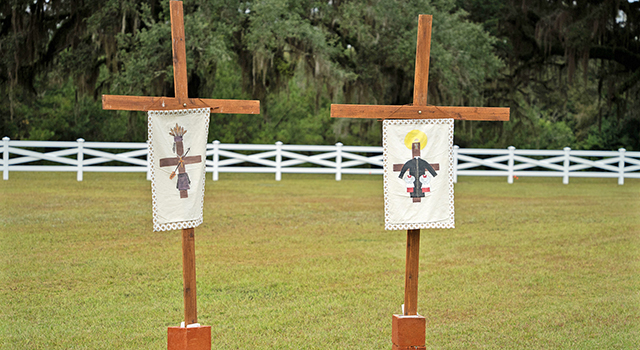By Jean Gonzalez - Florida Catholic - Orlando
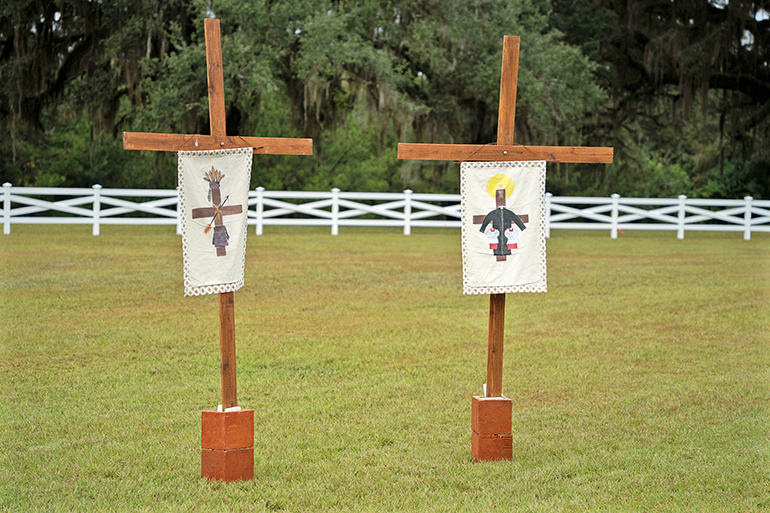
Photographer: DIOCESE OF PENSACOLA-TALLAHASSEE
These two banners represent the Native American martyrs, left, and the Domincan martyrs, right, who perished in North Florida and died for their faith. The banners were on display during the closing of the diocesan phase of the cause for canonization of Antonio Inija and the 57 companions Oct. 12, 2023 in Tallahassee.
ORLANDO | Lay Catholics and clergy researched, chronicled and verified a piece of Florida’s Catholic history from more than three centuries ago in hopes it will become a piece of Catholic history for the universal church.
And eight years after this process officially began, a Mass marked the affirming, signing and sealing of documents to be delivered the Dicastery for the Causes of Saints in Rome in support of the canonization of Antonio Inija and the 57 companions.
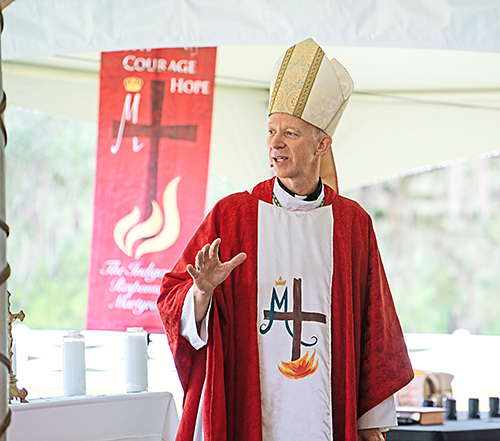
Photographer: DIOCESE OF PENSACOLA-TALLAHASSEE
Holy Cross Bishop William Wack, of Pensacola-Tallahassee, offers his remarks at the Mass marking the closing of the diocesan phase for the cause for canonization of Antonio Inija and 57 companions Oct. 12, 2023. The cause unites nine U.S. dioceses and Bishop Wack serves as bishop of competency.
Holy Cross Bishop William Wack, of Pensacola-Tallahassee, served as main celebrant of the Mass, Oct. 12, 2023, that marked the closing of the diocesan phase and the beginning of the Roman phase for the cause. Some 650 supporters — laity and clergy, members of indigenous tribes and Florida residents — gathered at a site along El Camino Real in rural Tallahassee. Primary documents indicate that on or near that land – just west of the land where Mission San Pedro y Pablo de Patale stood – the missionary priests and indigenous Catholics, many of the Apalachee tribe, were martyred.
In his homily, Bishop Wack recounted reading stories of different martyrs from across the world who gave the ultimate sacrifice to proclaim the Lord. He said those stories stirred his young heart. So he rejoiced in the opportunity to celebrate and honor those murdered in Florida because of their Catholic faith.
“They are not from some far-off lands. They are from this land right here. Maybe even this land where we are literally standing upon is where they spilled their blood, offered their blood for the Lord,” Bishop Wack said. “We are proud of that. Proud we can lift them up and make them known to the whole world. It is our hope they are declared martyrs by Rome because we want the whole world to be inspired by them ... so that little children can read about them and stir their hearts like mine as they live for the Lord.”
The cause revolves around Catholics who were indigenous in what is present-day Florida and missionaries from outside America who were martyred in the name of God from 1549 to 1712. The cause documents the historical accounts, especially during the 1704 massacre in which Antonio Inija and many other natives were captured, killed and, in some cases, tortured by Col. James Moore, governor of the Carolinas, and his Creek allies, in the name of Queen Anne of England.
The atrocious massacre offers further evidence that the missionaries established missions, not slave camps, among the indigenous.
While the Spanish fought side-by-side with Apalachees against the aggressors, no large Spanish military force was present to aid in opposing the English aggression.
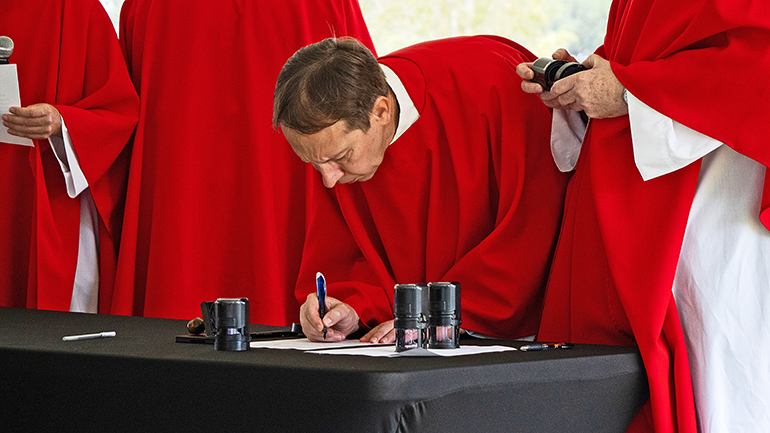
Photographer: DIOCESE OF PENSACOLA-TALLAHASSEE
Father Len Plazewski signs documents affirming he carried out his responsibilities "true and correct" as vice-postulator of the canonization cause of Antonio Inija and the 57 companions.
“When the indigenous were captured, they were given the opportunity to defame their faith and they chose horrible deaths rather than capitulating to denying the faith,” Father Len Plazewski explained to the Florida Catholic in 2022. The pastor of Christ the King Parish in Tampa served as one of the cause’s five vice postulators. “Col. Moore went from mission to mission wiping out all he could and took native peoples who could not escape as slaves. ... Col. Moore hated Catholics with a passion. The fact was that he did fight to advance the British Empire, but he was also attacking people he hated. It was in present terms ‘human rights abuses,’ with his motivation coming from his hatred of the Catholic Church and Catholic faith. He wasn’t trying to make allies among people; he was trying to subjugate them.”
When Antonio Inija was captured, he was tortured by Moore’s forces. He and others were tied to stakes and their feet were set on fire when they refused to renounce their faith. Despite this torture, the Catholic natives encouraged each other and attempted to evangelize their tormentors.
Those murdered in the massacres included individuals and missionary priests from Spain and Cuba of different religious orders — Dominicans, Jesuits, Franciscans and St. John of God. The indigenous killed included men, women and children (including one unborn child) from the Apalachee, Aypaja, Guale and Timucua tribes.
INDIGENOUS REPRESENTATION
Indigenous Americans were represented at the Mass in support of the cause. On the altar was Deacon Andrew Orosco, Ipai-Kumeyaay, San Pasqual Band. He is the first Ipai-Kumeyaay/Tongva-Gabrielino ordained deacon serving the Diocese of San Bernardino, California, which has within its boundary 13 federally recognized tribes. One of the readings was offered by Sister of St. Anne Kateri Mitchell, of the Akwesasne community. A religious for more than 60 years, she is retired executive director of the Tekakwitha Conference, an annual gathering for those who minister to Native American Catholics.
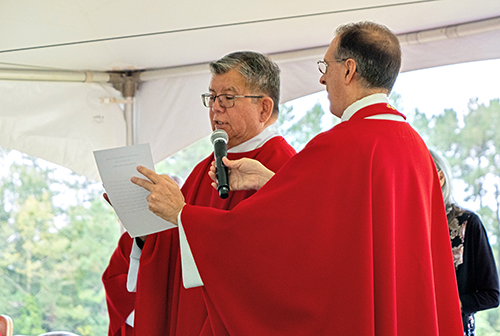
Photographer: DIOCESE OF PENSACOLA-TALLAHASSEE
Father Maurice Henry Sands, left, takes the oath affirming he carried out his responsibilities "true and correct" as vice-postulator of the canonization cause of Antonio Inija and the 57 companions with Father Timothy Lindenfelser, pastor of St. Anastasia Parish in St. Augustine. Father Sands, director of the National Black and Indian Mission Office in Washington, D.C., is a native indigenous person in Canada and United States.
One of the five vice postulators of the cause included Father Maurice Henry Sands, executive director of the Black and Indian Mission Office in Washington, D.C. He is an indigenous native in Canada and the United States and a member of three tribes — the Ojibwe (or Chippewa), Odawa (or Ottawa), and Potawatomi, known together as the Anishinaabe, or also the Three Fires.
“I was born in the First Nation community in Ontario. The name of the community is Bkejwanong, which means ‘Where the waters divide.’ It is a group of islands on the delta of the big river (St. Clair). I belong to the community in Canada and am a member of a tribe in Michigan — the Little Traverse Bay Bands of Odawa Indians.”
Father Sands became familiar with the Florida martyrs cause in 2014, during a history conference organized to discuss them. There he met one of his fellow vice postulators, Father Plazewski. Father Sands was initially involved with the canonization commission, as he had experience in other canonization causes for indigenous people. Later, he was invited to become a vice postulator.
He described the cause as “incredibly meaningful,” as indigenous Catholics have “much gratitude and pride” as the cause moves forward, and their stories and histories become “cemented in the universal Church.”
“The martyrs lived lives of virtue and are looked up as role models and sources of inspiration,” Father Sands said. “They are worthy to be emulated.”
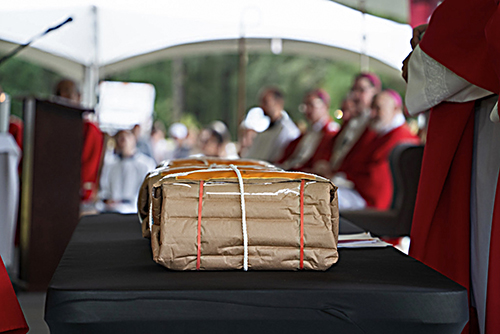
Photographer: DIOCESE OF PENSACOLA-TALLAHASSEE
Three sealed packages housing the more than 2,700 documents from the historical commission and tribunal are ready to be escorted by Msgr. Michael Reed, chancellor of the Pensacola-Tallahassee Diocese, to be delivered to Rome to the Dicastery for the Causes of Saints.
Indigenous people have faced persecution from different directions, including, at times, from people of faith. But Father Sands agreed with the findings of the historical commission that the pastoral presence of missionaries within the indigenous population in what is now North Florida was peaceful. The missionaries lived up to the tenet that God gives all free will and while shared, the Gospel should not be forced upon others. Father Sands added that if the missionaries were forcing the Gospel on the indigenous, they would not be allowed to live within the community, which they did.
“Forcing the Gospel on others is not consistent with what the missionaries were taught. They were proclaiming the Gospel,” Father Sands said. “I am very impressed at how robustly these indigenous people in Northern Florida embraced the faith, so much so they stood up for the faith in the face of being threatened with torture and death. I’m impressed how powerfully the Lord worked in their lives and they gave of themselves to the Lord.”
Having the cause move forward is another way indigenous peoples of the Americas can have a connection with their past. Indigenous people have faced serious injustices that need to be addressed, including the tragic reality that many were taken away from their communities, deprived of their connection to their relatives or even their parents.
“Throughout their whole history since the time first Europeans arrived there have been vigorous efforts to wipe out (tribes) and despite all that, the indigenous have survived. ... There is a really strong instinct that indigenous people be connected to culture, language and family,” Father Sands said. “These martyrs and the opportunity to recognize them as they offered their lives for the sake of the faith in the face of who wanted to eliminate them is an important connection to preserve. They are really great heroes for everyone, not just indigenous. It will prompt others to learn more about them and to realize indigenous people have been part of the history of the church since missionaries up to present day.”
IMPRESSED THE KING
The extraordinary faith and holy death of these Florida natives captured the admiration of the Spanish monarch at the time, King Philip V, who directed his ambassador in Rome to inform Pope Clement XI of this event. Through the centuries, others have picked up the mantle to honor the martyrs. In the 1930s, Bishop John Gannon of Erie, Pennsylvania, an advocate for all the U.S. martyrs, brought the cause to the attention of the U.S. bishops. Retired Bishop Rene H. Gracida of Corpus Christi, Texas, founding bishop of the Pensacola-Tallahassee Diocese, took the first steps to open the cause in the 1980s.
But the cause truly became official when two women — Lynn Mangan and the late Heather Jordan — approached Bishop Gregory Parkes, then bishop of Pensacola-Tallahassee — and pleaded with him to officially launch the process. Now serving as bishop of St. Petersburg, Bishop Parkes participated in the Mass and recalled that day.
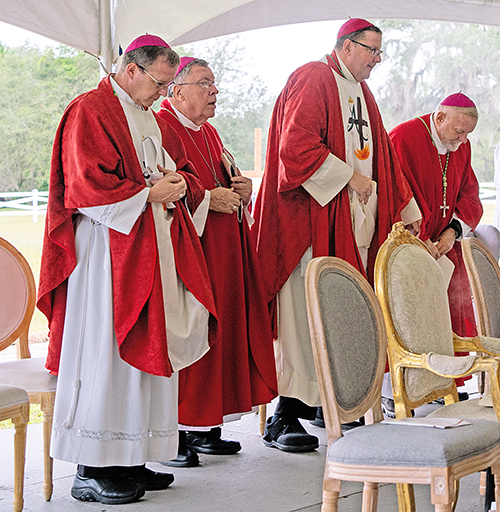
Photographer: DIOCESE OF PENSACOLA-TALLAHASSEE
Bishop Erik Polhmeier of St. Augustine, left, Bishop Emeritus Robert Baker of Birmingham, Alabama, Bishop Gregory Parkes of St. Petersburg and Archbishop Thomas Wenski of Miami participate in Mass in Tallahassee Oct. 12, 2023, marking the end of the diocesan phase of the cause for canonization of Antonio Inija and the 57 companions. Nine U.S. dioceses united for the cause of the martyrs who include indigenous peoples and religious clergy.
“After meeting with them something in my heart told me that while there were stops and starts, that it was finally time once and for all to move forward and to open the cause,” he said. “You are here because you are people of faith and believe in this cause that those who gave their lives for the faith should be honored. ... It’s so important that we recognize them for their history but look to them for their inspiration, guidance and prayers. Particularly for our young people today. Our church needs holy men and women as examples to inspire us to greater holiness and greater virtue, to pray for us on our journey to the kingdom.”
The cause unites nine dioceses, including six Florida dioceses — Pensacola-Tallahassee, St. Augustine, Venice, Orlando, St. Petersburg and Palm Beach — and the Dioceses of Savannah, Georgia, Mobile, Alabama, and Richmond, Virginia. Since the site of the massacre of the lead martyr — Antonio Inija — occurred within what is now the Pensacola-Tallahassee Diocese, the eight other dioceses transferred the signing responsibilities to Bishop Wack.
During the Mass, three packages of documents were signed, verified and sealed by members of the historical commission (which collected evidence of the martyrdom) and the tribunal (which collected witness testimonies and other documents). In total, there were 1,255 pages from the historical commission and 1,468 pages from the tribunal.
In November, Msgr. Michael Reed, chancellor of the Pensacola-Tallahassee Diocese, escorted the documents to Rome for delivery to the Dicastery for the Causes of Saints.
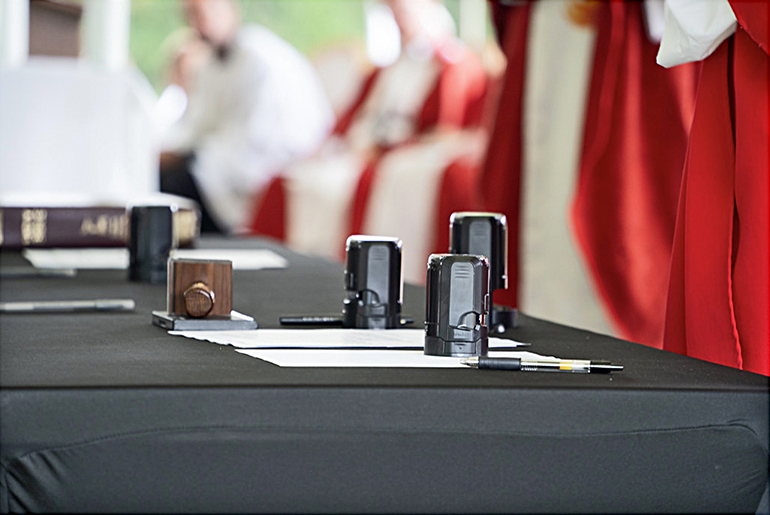
Photographer: DIOCESE OF PENSACOLA-TALLAHASSEE
On this table are the seals to be used by the vice-postulators, notary, episcopal delegates, promotors of justice, and bishop of competency. Each member of the commissions for the cause of canonization for Antonio Inija and the 57 companions sign and seal documentation that will be sent to the Dicastery for the Causes of Saints in Rome.
